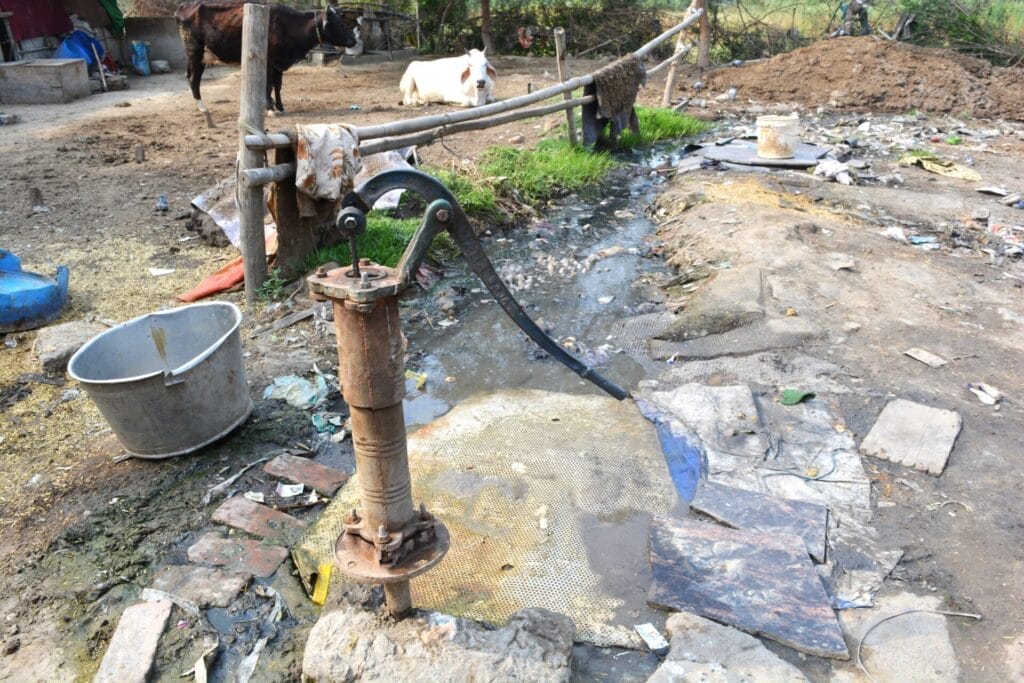Every afternoon in Delhi’s Yamuna Khadar, a daily ritual unfolds as the residents, mainly migrant workers from Bihar working as waste collectors, anxiously wait for the arrival of the Delhi Jal Board’s (DJB) water tanker. The tanker stops at the far end of a kutcha road lined with shanties and heaps of garbage.
Usually, children aged 5 to 6 enthusiastically run to announce the arrival of the tanker. Soon after, women arrive, balancing large containers in their arms and around their waists, while men on bicycles hastily make their way to the main road. For the people here, this water supply is an essential lifeline. Without it, they would either find themselves parched, or would have to quench their thirst by burning a hole in their pockets.
Read more: When families live on three pots of water a day: Lessons from Chennai slums
Water tales
30-year-old Devi moves mechanically as she scrubs a heap of utensils before dipping them into the murky pond water and setting them aside. Along with her, five other women are repeating the same process. Devi is from Bihar, but has been living in New Delhi for the past 16 years. Throughout this time, she has been working as a waste picker, earning just a little over Rs 100 a day.
Initially unsure about me, a stranger disrupting her daily routine, she eventually relents after my persistent attempts to start a conversation about the water they were using. She then tells me, “Hum isi mein kapde dhote hain, isi mein nahate hain, isi mein bartan bhi dhote hain [We use this water for everything: washing clothes, bathing, cleaning utensils.]”
Devi goes on to explain that using this water exposes them to a number of diseases, especially skin disorders. When it comes to drinking water, she has to rely on the tanker, which provides them with only one or two bottles of water a day.
Scarce alternatives
According to a study conducted in 2023, approximately 18 to 26% of the urban population lacks access to piped water, predominantly in unplanned colonies where in-home plumbing is scarce. These residents typically depend on community taps or tanker trucks for water supply, which is both costly and inconsistent.
At Yamuna Khadar, community members tell me that there are occasions when the DJB’s tanker fails to arrive for two to three days at a stretch. On such days, they find themselves compelled to either depend on relatively costly private tankers or resort to using visibly contaminated water from the Yamuna’s pond for daily activities such as cleaning and bathing.
Some days, they approach a residential colony in the nearby Chilla Gaon, where they work as waste collectors, seeking a small amount of water for their daily needs.
Health implications
In the area, there’s only a single hand pump available for more than 500 people. Unfortunately, the water from this hand pump is described as “yellow” and has been known to cause illnesses, particularly among children.
Read more: Delhi Report Card (2020): Enough ‘free lifeline water’ for all, but quality and impact under scanner
Aarti, who tells me that she does not know her age, is from Harnaut, Bihar. Like many other people living in Yamuna Khadar, she has also been living in Delhi for a long time now, making her living as a waste picker. In fact, as she speaks to me, she is sitting atop a pile of motley waste that she is segregating using her bare hands. I asked Aarti if she could tell me about the water situation in her area.
She told me her four children keep falling sick because of the poor water quality in the area. Most of the money she earns goes towards their treatment. Nevertheless, due to the absence of any alternative sources, she still uses the pond water or the water from the handpump. “Ham sabko bukhaar hai [We all have fever],” she says, while other women around us agree.

Aarti also mentions that there has been almost no official effort to solve their problems or even register their complaints. They are labelled as encroachers, living under the ever looming threat of their makeshift homes being demolished by the Delhi Development Authority (DDA). Accessing water, therefore, is just one of the many challenges they face for survival.
Before I can ask her further, a few children announce from far away that the tanker has arrived. And I stand witness to a rather unnerving scene playing out at the margins of our national capital, one of the world’s largest metro cities, Delhi. Crowds of people rush towards the end of the road, too anxious to bother about the weight in their hands. It is an endless race, for a few litres of drinking water. Tomorrow, the same cycle will be repeated.
Note: The author is one of six selected Fellows for the “Citizen Matters – Urban Environmental Reporting Fellowship 2023” focusing on the Delhi-NCR region. This short piece was produced as part of her work under the Fellowship.